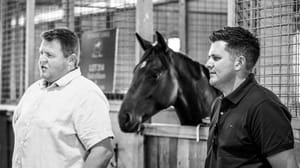Data could prove key to unlocking solutions to thoroughbred welfare and traceability challenges but those pioneering the data-led change in approach have been urged not to rely on assistance from regulators.

Tom Seymour, who is the founder of digital breeding management tool Breedr, recently convened the Equate conference in Scone with a focus on high-performance racing data, welfare tracking devices, artificial intelligence (AI) and microchip technology, all via demonstrations of technology products already operating in different sectors of the thoroughbred industry.
What emerged from the conference, according to Seymour, was a collective will from those attending to be proactive in seeking new solutions rather than wait for regulators, Principal Racing Authorities or other industry bodies, to drive change.
“There was a tangible, new-found willingness from a broad cross-section of the industry to learn and engage. It has given me a great deal of optimism that there's been a slight nudge in the innovation dial,” Seymour said.
Among the Australian thoroughbred industry’s host of challenges is the lack of a cohesive national approach on change or innovation. Seymour said the conference, which featured eight speakers from thoroughbred and non-thoroughbred backgrounds, identified significant opportunities.
The clearest of those was in data aggregation and the opportunity to utilise that data to improve horse welfare.
“There are already products in play, organically capturing critical data as part of their everyday service provision to the industry,” he said.
“It was incredible to see what each product was achieving in isolation, but what was very clear, if we were able to put all that data together, as we would be willing to do, we would make huge advances in the early identification of illness and decreasing risk of injury.”
Seymour said the sharing of data collected by a host of the companies who attended Equate presented a "powerful" opportunity for the private sector to go it alone and invest in building solutions.
Seymour believes private investment or the “establishment of an innovation fund might be our only option”.
“If only our regulators would engage in conversation with those already in the marketplace,” he said.

Among the speakers was Andrew Smith from Dairy Australia, who pointed to how innovation elsewhere in the agricultural sector had been led by private investment.
“What they've learned in the dairy industry is that the speed that innovation/technology is moving is far greater than what the ability of the regulators, or Dairy Australia in this instance, was able to regulate or get their head around,” Seymour said.
“And so they made a conscious decision to just drive on. To say the regulator needs to try and catch up.”
Seymour acknowledged that innovation could come from within the regulatory environment as well.
Racing Australia is charged with being the central repository of all key thoroughbred racing and breeding data in Australia and has reportedly been working on a new data solution.

However, details on the project have not been forthcoming. Seymour said there is currently no clarity as to what this new system may look like and no guarantee it will accept third-party data.
“If we had just a minimal amount of transparency or insight into the new systems, it would give operators like myself the confidence to invest in our own R&D. Without any idea on what tech the new systems will be built on or what type of data it will accept, we are forced just to press on in our individual ecosystems,” he said.
He said that his company Breedr, would benefit from a broader availability of data, but that his interest in a sharing project extended far beyond self-interest.
“If we get it right, everyone stands to benefit and we can look forward to an innovative future. In contrast, if the industry powers keep the curtain up and just deliver their interpretation, we might as well throw away the keys for the next decade,” he said.
“As Neal French from Google pointed out in his presentation, AI is moving at a speed of x10, proving we need to be thinking about what’s needed in 5-10 years, not just solutions to today’s problems.
“We need to evolve into a data-driven industry and recognise the importance of collating data at every touch point, and this will go a long way to make our industry a little more appealing to the next generation of employees and investors.”
“In the meantime, we will continue to work together, support each other and drive further innovation solutions that benefits everyone – when the industry bodies want to join in the conversation, we would welcome them."








